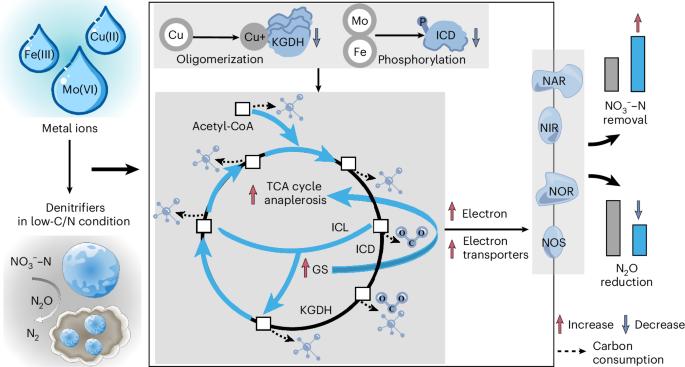Efficient denitrification and N2O mitigation in low-C/N wastewater treatment by promoting TCA cycle anaplerosis via glyoxylate shunt regulation
IF 24.1
引用次数: 0
Abstract
Conventional biodenitrification for water with a low carbon-to-nitrogen ratio (C/N) demands exogenous carbon, exacerbating carbon consumption and emissions. Here we propose a metabolic reprogramming strategy leveraging Mo(VI)–Fe(III)–Cu(II) synergy to redirect carbon flux through the glyoxylate shunt (GS), enhancing tricarboxylic acid cycle anaplerosis for efficient denitrification and reduced greenhouse gases during low-C/N wastewater treatment. At a C/N of 3, Mo(VI)–Fe(III)–Cu(II) promoted carbon metabolism by the tricarboxylic acid cycle in Paracoccus denitrificans, elevating reducing power (electron carriers) production and electron transporter activity. This increased total nitrogen removal by 196.2% compared with the blank control and by approximately 32.0–146.6% compared with single- or dual-metal-supplemented controls, while reducing nitrous oxide emissions by 51.3% and approximately 26.2–85.6%, respectively. This effect originated from the inhibition of isocitrate dehydrogenase and α-ketoglutarate dehydrogenase by Mo(VI)–Fe(III)–Cu(II), causing isocitrate accumulation that activates isocitrate lyase of the glyoxylate shunt and prioritizes GS-driven anaplerosis. Finally, activated sludge validation increased 31.7% total nitrogen removal efficiency, highlighting the approach’s practical potential. This carbon-metabolism reprogramming strategy reduces organic carbon demand in denitrification, enhancing energy efficiency and advancing carbon-neutral wastewater treatment. This study proposes a strategy for enhancing denitrification in low-C/N wastewater by redirecting carbon flux through glyoxylate shunt regulation.

通过乙醛盐分流调节促进TCA循环修复,在低c /N废水处理中有效反硝化和减少N2O
低碳氮比(C/N)水的传统生物反硝化需要外源碳,加剧了碳消耗和排放。在这里,我们提出了一种代谢重编程策略,利用Mo(VI) -Fe (III) -Cu (II)协同作用,通过乙醛酸分流(GS)重新定向碳通量,增强三羧酸循环反应,在低碳/氮废水处理过程中有效反硝化和减少温室气体。在C/N为3时,Mo(VI) -Fe (III) -Cu (II)促进了反硝化副球菌三羧酸循环中的碳代谢,提高了还原能力(电子载流子)的产生和电子传递体的活性。与空白对照相比,总氮去除率提高了196.2%,与单一或双金属补充对照相比,总氮去除率提高了约32.0-146.6%,同时氧化亚氮排放量分别降低了51.3%和约26.2-85.6%。这种效应源于Mo(VI) -Fe (III) -Cu (II)对异柠檬酸脱氢酶和α-酮戊二酸脱氢酶的抑制作用,导致异柠檬酸积累,激活乙醛酸分流的异柠檬酸裂解酶,优先考虑gs驱动的骨质疏松。最后,活性污泥验证提高了31.7%的总氮去除效率,突出了该方法的实用潜力。这种碳代谢重编程策略减少了反硝化过程中的有机碳需求,提高了能源效率,推进了碳中性废水处理。本研究提出了一种通过乙醛盐分流调节重定向碳通量来增强低碳/氮废水反硝化的策略。
本文章由计算机程序翻译,如有差异,请以英文原文为准。
求助全文
约1分钟内获得全文
求助全文

 求助内容:
求助内容: 应助结果提醒方式:
应助结果提醒方式:


